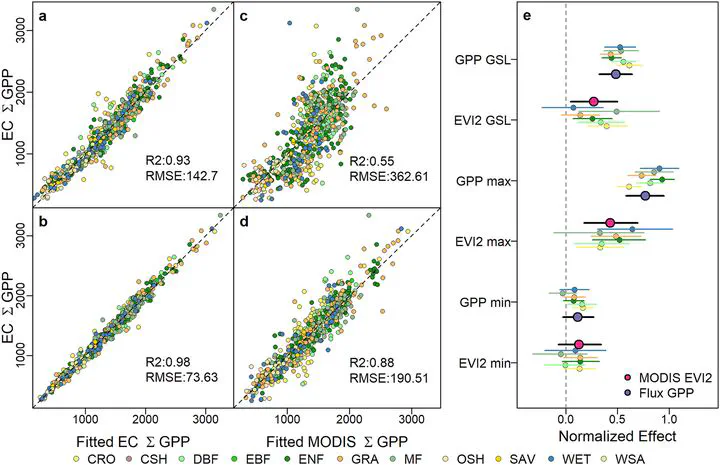Observations of Satellite Land Surface Phenology Indicate That Maximum Leaf Greenness Is More Associated With Global Vegetation Productivity Than Growing Season Length
Mar 6, 2023· ,,,,·
1 min read
,,,,·
1 min read
Xiaojie Gao (高孝杰)
Ian R. McGregor
Josh M. Gray
Mark A. Friedl
Minkyu Moon
 Bayesian hierarchical model results (Fig 3 of the paper)
Bayesian hierarchical model results (Fig 3 of the paper)Abstract
Vegetation green leaf phenology directly impacts gross primary productivity (GPP) of terrestrial ecosystems. Satellite observations of land surface phenology (LSP) provide an important means to monitor the key timing of vegetation green leaf development. However, differences between satellite-derived LSP proxies and in situ measurements of GPP make it difficult to quantify the impact of climate-induced changes in green leaf phenology on annual GPP. Here, we used 1,110 site-years of GPP measurements from eddy-covariance towers in association with time series of satellite LSP observations from 2000 to 2014 to show that while satellite LSP explains a large proportion of variation in annual GPP, changes in green-leaf-based growing season length (GSL, leaf development period from spring to autumn) had less impact on annual GPP by ∼30% than GSL changes in GPP-based photosynthetic duration. Further, maximum leaf greenness explained substantially more variance in annual GPP than green leaf GSL, highlighting the role of future vegetation greening trends on large-scale carbon budgets. Site-level variability contributes a substantial proportion of annual GPP variance in the model based on LSP metrics, suggesting the importance of local environmental factors altering regional GPP. We conclude that satellite LSP-based inferences regarding large-scale dynamics in GPP need to consider changes in both green leaf GSL and maximum greenness.
Type
Publication
Global Biogeochemical Cycles